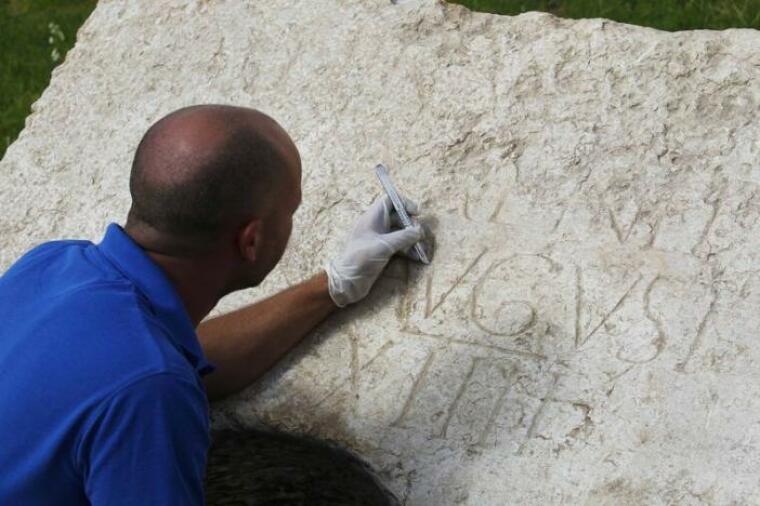Israeli archaeologists open up storeroom to provide glimpse into life during Christ's time

The Israel Antiquities Authority (IAA) has opened up its storerooms containing artifacts that provide clues to what life was like during the time of Jesus Christ.
The vast warehouse was opened up to reporters on Sunday, ahead of the upcoming Christian holiday of Easter, which marks the resurrection of Christ after his crucifixion.
Among the archaeological treasures from the first century A.D. discovered around Jerusalem and Galilee are vases, cooking utensils, a wine press, crucifixion nails, jewelry, and ossuaries, according to AFP.
Some of the ossuaries were inscribed with the name of Jesus, which archaeologists say was a common name in Israel 2,000 years ago. Around 30 ancient burial boxes were found inscribed with the same name.
The experts said that they have yet to find archaeological evidence that directly links to Jesus, but in recent years, they have discovered an array of materials that could help historians understand how Jesus may have lived or died.
Gideon Avni, head of the IAA's archaeology division, said that there are more than one million objects under the custody of the IAA, and there are about 40,000 new finds from about 300 archaeological sites each year.
"Nowadays we can restore in a very clear way the daily life during that period, from the moment of birth, through the person's life, his dining customs, where he travelled across the land, and until his day of death including his burial," said Avni.
"Over the past 20 years we have made a great leap in understanding the way of life of Jesus and his contemporaries. Every week new elements are discovered which allow a better understanding of this period," he added.
The IAA also exhibited a replica of a heel bone pierced by an iron nail with wood fragments on each end. The artifact, located in the Israel Museum in Jerusalem, was found in a Jewish burial box in northern Jerusalem, dating back to the first century A.D. Up to this time, it is the only evidence of a victim of a Roman crucifixion buried according to Jewish custom.
The artifact has helped archaeologists in the reconstruction of the man's crucifixion, with his feet nailed to the sides of the cross. Avni expressed his belief that Jesus may have been crucified in the same way, which is different from the traditional depictions of crucifixion in art.
Avni said that there is no reason to doubt Jesus' existence just because archaeologists have not found any physical evidence of him.
"You have to remember that Christ was one among more than a million people living during this time in the Holy Land," he said.
 Christians don't have to affirm transgenderism, but they can’t express that view at work: tribunal
Christians don't have to affirm transgenderism, but they can’t express that view at work: tribunal Archaeology discovery: Medieval Christian prayer beads found on Holy Island
Archaeology discovery: Medieval Christian prayer beads found on Holy Island Presbyterian Church in America votes to leave National Association of Evangelicals
Presbyterian Church in America votes to leave National Association of Evangelicals Over 50 killed in 'vile and satanic' attack at Nigerian church on Pentecost Sunday
Over 50 killed in 'vile and satanic' attack at Nigerian church on Pentecost Sunday Ukrainian Orthodox Church severs ties with Moscow over Patriarch Kirill's support for Putin's war
Ukrainian Orthodox Church severs ties with Moscow over Patriarch Kirill's support for Putin's war Islamic State kills 20 Nigerian Christians as revenge for US airstrike
Islamic State kills 20 Nigerian Christians as revenge for US airstrike Man who served 33 years in prison for murder leads inmates to Christ
Man who served 33 years in prison for murder leads inmates to Christ


 Nigerian student beaten to death, body burned over ‘blasphemous’ WhatsApp message
Nigerian student beaten to death, body burned over ‘blasphemous’ WhatsApp message 'A new low': World reacts after Hong Kong arrests 90-year-old Cardinal Joseph Zen
'A new low': World reacts after Hong Kong arrests 90-year-old Cardinal Joseph Zen Iran sentences Christian man to 10 years in prison for hosting house church worship gathering
Iran sentences Christian man to 10 years in prison for hosting house church worship gathering French Guyana: Pastor shot dead, church set on fire after meeting delegation of Evangelicals
French Guyana: Pastor shot dead, church set on fire after meeting delegation of Evangelicals ‘Talking Jesus’ report finds only 6% of UK adults identify as practicing Christians
‘Talking Jesus’ report finds only 6% of UK adults identify as practicing Christians Mission Eurasia ministry center blown up in Ukraine, hundreds of Bibles destroyed: 'God will provide'
Mission Eurasia ministry center blown up in Ukraine, hundreds of Bibles destroyed: 'God will provide' Church holds service for first time after ISIS desecrated it 8 years ago
Church holds service for first time after ISIS desecrated it 8 years ago Burger King apologizes for 'offensive campaign' using Jesus' words at the Last Supper
Burger King apologizes for 'offensive campaign' using Jesus' words at the Last Supper Uganda: Muslims abduct teacher, burn him inside mosque for praying in Christ’s name
Uganda: Muslims abduct teacher, burn him inside mosque for praying in Christ’s name